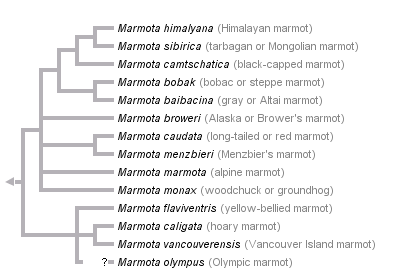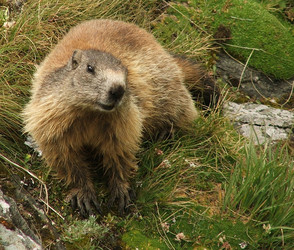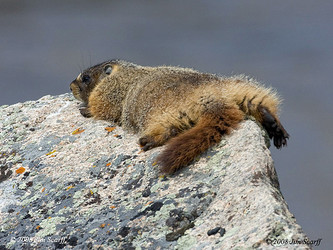Marmota



This tree diagram shows the relationships between several groups of organisms.
The root of the current tree connects the organisms featured in this tree to their containing group and the rest of the Tree of Life. The basal branching point in the tree represents the ancestor of the other groups in the tree. This ancestor diversified over time into several descendent subgroups, which are represented as internal nodes and terminal taxa to the right.

You can click on the root to travel down the Tree of Life all the way to the root of all Life, and you can click on the names of descendent subgroups to travel up the Tree of Life all the way to individual species.
For more information on ToL tree formatting, please see Interpreting the Tree or Classification. To learn more about phylogenetic trees, please visit our Phylogenetic Biology pages.
close boxReferences
Armitage, K. B. 1975. Social behavior and population dynamics of marmots. Oikos 26:341-354.
Armitage, K. B. 1999. Evolution of sociality in marmots. J. Mamm. 80:1-10.
Arnold, W. 1990. The evolution of marmot sociality: II. Cost and benefits of joint hibernation. Behav. Ecol. Sociobiol. 27:239-246.
Barash, D. P. 1989. Marmots. Social behavior and ecology. Stanford Univ. Press, Palo Alto, California.
Bibikov, D. I. 1996. Die Murmeltiere der Welt. Spektrum Akademischer Verlag, Heidelberg.
Black, C. C. 1963. A review of the North American Tertiary Sciuridae. Bull. Mus. Comp. Zool. 130:109-248.
Giboulet, O., P. Chevret, R. Ramousse, and F. Catzeflis. 1997. DNA-DNA hybridization evidence for the recent origin of marmots and ground squirrels (Rodentia: Sciuridae). J. Mammal. Evol. 4:271-284.
Gromov, I. M., D. I. Bibikov, N. I. Kalabukhov, and M. N. Meier. 1965. Fauna SSSR. Mlekopitayushchie, Volume 3, no. 2. Nazemnye Belich’i (Marmotinae) [Fauna of the USSR. Mammals, Volume 3, no. 2.Ground Squirrels (Marmotinae)]. Nauka, Moscow.
Hafner, D. J. 1984. Evolutionary relationships of the Nearctic Sciuridae. Pages 3-23 in The biology of ground-dwelling ground squirrels (J. O. Murie and G. R. Michener, eds.). Univ. Nebraska Press, Lincoln, Nebraska.
Hoffmann, R. S., C. G. Anderson, R. W. J. Thorington, and L. R. Heaney. 1993. Family Sciuridae. Pages 419-465 in Mammal species of the world (D. E. Wilson and D. M. Reeder, eds.). Smithsonian Institution Press, Washington, D.C.
Hoffmann, R. S., J. W. Koeppl, and C. F. Nadler. 1979. The relationships of the amphiberingian marmots (Mammalia: Sciuridae). Occas. Pap. Mus. Nat. Hist. Univ. Kansas 83:1-56.
Hoffmann, R. S., and C. F. Nadler. 1968. Chromosomes and systematics of some North American species of the genus Marmota (Rodentia: Sciuridae). Experientia 24:740-742.
Kruckenhauser, L., W. Pinsker, E. Haring, and W. Arnold. 1999. Marmot phylogeny revisited: molecular evidence for a diphyletic origin of sociality. J. Zool. Syst. Evol. Research 37:49-56.
Rausch, R. L., and V. R. Rausch. 1971. The somatic chromosomes of some North American marmots (Sciuridae), with remarks on the relationships of Marmota broweri Hall and Gilmore. Mammalia 35:85-101.
Steppan, S. J., M. R. Akhkverdyan, E. A. Lyapunova, D. G. Fraser, N. N. Vorontsov, R. S. Hoffmann, and M. J. Braun. 1999. Molecular phylogeny of the marmots (Rodentia: Sciuridae): tests of evolutionary and biogeographic hypotheses. Syst. Biol., 48:715-734.
Thomas, W. K., and S. L. Martin. 1993. A recent origin of marmots. Mol. Phylogenet. Evol. 2:330-336.
Vorontsov, N. N., and E. A. Lyapunova. 1984. Genetics and problems of trans- Beringian connections of Holarctic mammals. Pages 441-463 in Beringia in the Cenozoic era (V. L. Kontrimavichus, eds.). Oxonian Press, New Delhi, India.
Title Illustrations

| Scientific Name | Marmota marmota |
|---|---|
| Location | Hochalpenstraße, about 3500 m, Großglockner, Austria |
| Specimen Condition | Live Specimen |
| Source | Alpine Marmot |
| Source Collection | Flickr |
| Image Use |
 This media file is licensed under the Creative Commons Attribution-NonCommercial License - Version 2.0. This media file is licensed under the Creative Commons Attribution-NonCommercial License - Version 2.0.
|
| Copyright | © 2005 Richard Lowkes |
| Scientific Name | Marmota flaviventris |
|---|---|
| Location | Yellowstone National Park, Wyoming, USA |
| Specimen Condition | Live Specimen |
| Source | It's so exhausting being a marmot! |
| Source Collection | Flickr |
| Copyright |
© 2008 Jim Scarff

|
About This Page
Correspondence regarding this page should be directed to Scott J. Steppan at
Page copyright © 2001 Scott J. Steppan
All Rights Reserved.
Citing this page:
Tree of Life Web Project. 2001. Marmota. Version 01 January 2001 (temporary). http://tolweb.org/Marmota/16776/2001.01.01 in The Tree of Life Web Project, http://tolweb.org/









 Go to quick links
Go to quick search
Go to navigation for this section of the ToL site
Go to detailed links for the ToL site
Go to quick links
Go to quick search
Go to navigation for this section of the ToL site
Go to detailed links for the ToL site